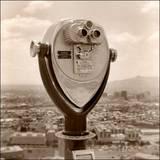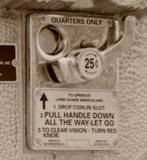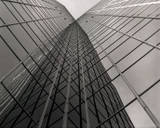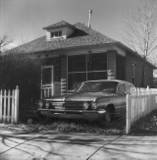An Appreciation
home vintage cameras index

Designer: Arthur H. Crapsey, Jr.



el paso

dead man's curve
The commonest close-up lens, the No. 13, allowed the photographer to get to within about 3.5 feet of the subject - ideal for portraits and other close studies. It has also been suggested that adding the close-up lens provided some correction of abberations of the simple meniscus design of the main lens.
The camera, while advanced in many ways, was not perfect. While it had a time release function activated by the slide opposite the shutter, there was no cable release to help avoid camera movement during a long exposure. There was also no tripod mounting receptacle. Probably the biggest weakness in the camera, however, was a rather stiff shutter which tended to jar the camera when released, causing a blurred image if extraordinary care was not exercised in bracing the camera against the body or some handy object. Of course, it is not terribly difficult to rig up some kind of jury-rig tripod mount. One enthusiast, Diwan Bhathal, has come up with an elegant way to add both a tripod mount and a cable release with minimal cosmetic alteration of the camera. Pete Lutz found a similar solution for his Hawkeye Flash; some of the details may be seen at his f/6.3 Studio web site. If you are not the handy type, Randy Smith of Holgamods can add the cable release and tripod socket to your Hawkeye Flash, as well as providing a number of other functional and cosmetic enhancements to the camera.


margaret

santa fe
It is not usually necessary to remove the screws on either side of the top viewing screen; they are hard to take out and will probably be hard to put back. Just take out the screws above and below the lens ring on the front. Then, carefully lift the silver panel and remove the glass lens protector, the plastic retainer mount, and the front viewfinder lens for cleaning. You can reach in to clean the underside of the top viewfinder lens with a cotton swab.
The camera's lens and the shutter are accessed from inside the camera back. Remove the two phillips-head screws, take out the film holding frame and remove the lens and spring washer for cleaning. It might be a good idea to swab a little lighter fluid on the shutter mechanism at the same time. Be sure to replace the lens and washer in the proper order and orientation, and take care to properly seat the film holding frame. That's about it. Your camera is good for another fifty years, and maybe a couple more owners.
- Rejuvenating your Brownie Hawkeye
- Adding a cable release and tripod mount (Diwan Bhathal)
- Some flipped lens photos from the Hawkeye Flash on my blog.
- A pro who uses only the Hawkeye Flash!
- An amazing animation of BHF construction
- Randy Smith can add a cable release and tripod mount on your Hawkeye, as well as many other enhancements.



home vintage cameras index
 © mike connealy
© mike connealy